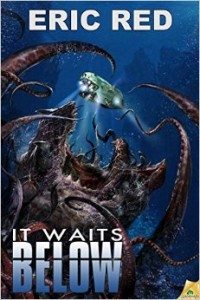
Eric Red
Samhain Publishing
2014
Reviewed by Michael R. Collings
Over a century and a half ago, according to the narrative that forms Eric Red’s It Waits Below, an unprecedented cosmic event occurred, a collision between the Corona, a Spanish warship laden with a golden treasure intended for the Emperor of Japan, and an interstellar wanderer, a comet forging a million-eons-long pathway through the stars until, in a one-in-a-billion chance it strikes and destroys the ship. And sends the treasure into the depths of the Mariana Trench, 30,000 feet down.
Now, in present day, the Enright brothers’ salvage operation is determined to retrieve the gold. With a specially equipped support tender and a radically re-designed submersible, they intend to descend deeper than humans have ever gone and, in an equally radically designed suit, walk on the bottom of the Trench into the ruins of the Corona.
Everything is set. Every contingency has been accounted for. Nothing can go wrong.
Except, of course, everything does.
Through accident and oversight, the submersible falls into an uncharted crevasse, well below crush-depth for both the DSV and the suit. On the surface, a violent storm rages and, far worse, pirates attack on the theory that the Enrights have already retrieved the treasure; all they will have to do is take it from them. Enough elements of hazard for any action-adventure tale.
But It Waits Below has one additional complication for its characters. Something is alive within the comet, something that has lived for millions of years in the frigid vacuum of space, and now, with the comet lodged inside the sunken wreck of the Corona, it discovers the possibility of new, warm hosts to infest, to control…and to change.
Although the story is a bit slow in the beginning, as the various actors are introduced and the circumstances detailed, once Red sets things in motion, It Waits Below transforms into a non-stop thriller, with none of the characters given a moment’s peace, a moment’s rest from the various forces that have gathered. It gains steam as the creature metamorphoses, consuming more and more of the life-forms around it, until it finally emerges to battle against the steel-plated tender itself. The final, apocalyptic scenes are described with all of the special effects of the best visual creature-features; and, in keeping with its genre, readers are challenged to guess who—if anyone—will survive.
A relatively short novel (270 pages), it is a fast-paced read. Characters are clearly limned, their motivations believable throughout. The settings—both above and below sea level—contribute to the texture, in particular the absolute blackness of the depths and the characters’ horror at being trapped there, helpless and unable to contact the outside world. The creature is grisly and horrific in all of its manifestations, some of which are shiveringly grotesque.
If there is anything about the novel that detracts from its effectiveness, it is the presence throughout of language problems—repetition of words, images, even clichés; long, awkwardly constructed sentences that require readers to stop and repeat to figure out how the pieces fit together; words misused or skewed that throw passages off balance; and abrupt shifts in diction from scientific-seeming to slang. The underlying story is sound; it would be well-served by a final, meticulous editorial sweep.
On the whole, however, there is much to appreciate, many tremors of horror to anticipate and endure, and the constant threat of destruction—of the divers, of the crew above, and indeed of humanity itself.








